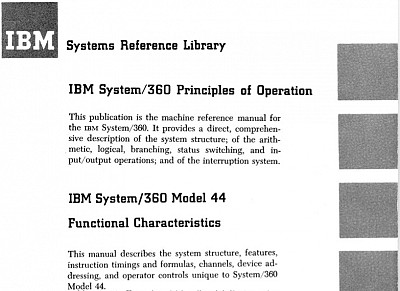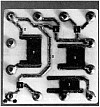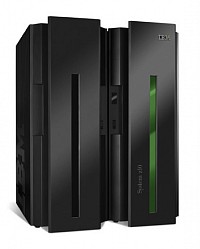Computer Science
Computing History Displays: Fourth Floor - IBM System/360
IBM announced the System/360 on April 7, 1964. It was a major event for the computer industry because IBM intended to discontinue all of their existing computers and peripheral devices (printers, card-readers, tape drives etc.) and replace them with one computer line, initially comprising six models at differing levels of performance and forty common peripherals. The name 360 and its logo conveyed the intention that the range was to be universal.
The 360 range's compatibility made the purchase decision easier for new customers. Customers of other vendors had to choose between machines they could outgrow and machines that were potentially overpowered (and thus too expensive). This meant that many companies simply didn't buy computers. The System/360 changed the entire nature of the market as companies could now install a cheaper "low end" machine without worry that it would be inadequate in the future. As well as providing a clear upgrade path for the smaller user, this change was intended to be of benefit to IBM. Rather than having different software and peripherals for different computers as in the past (IBM had a wide range of machines including quite-different "Scientific" machines in the 7090 series and the "Commercial" 1400 series), only one set of software needed to be written for all customers and their common range of peripheral devices.
The initial announcement was of Models 30, 40, 50, 60, 62, and 70. The first three were low- to middle-range systems aimed at the IBM 1400 series market. All three began shipping in mid-1965. The last three, intended to replace the 7000 series machines, never shipped and were replaced by the models 65 and 75. IBM actually delivered fourteen models of 360 including the cheapest 360 model 20 with as little as 4K of core memory, and the huge 360 model 92.
The 360 introduced many architectural features that are still widely used today. These include: the 8-bit byte (characters used 6 bits previously), byte-addressable memory (as opposed to word-addressable memory) and general purpose registers (to replace registers specialized for data or addressing.)
However, the big advance with the 360 was the concept of Instruction Set Architecture. Prior to the 360, a computer's architecture was a description of that particular computer's hardware. With the 360, architecture changed to be an interface for which software was written, independent of any implementation. Different manuals were used to describe the instruction-set architecture (the "Principles of Operation") and the detailed machines (the "Functional Characteristics.")
Being somewhat uncertain of the reliability and availability of monolithic integrated circuits, a new untested technology at the time, IBM chose instead to design custom hybrid integrated circuits using discrete transistors and diodes with silk-screened resistors on a ceramic substrate. Several of these were then mounted on a small multi-layer printed circuit board to make a "Solid Logic Technology" (SLT) module. The individual transistors - which could be considered to the most basic integrated circuit - were connected to the ceramic, face down, using tiny metal spheres (which later became "solder bumps" in the "flip chip" approach to packaging.)
Although SLT was considered by some to be a technology "behind the times" it proved to be very successful and provided the basis for circuit packaging that IBM continued to develop until the present day. IBM made the switch to integrated circuits with the 360's successor, the System/370, using SLT-style packaging.
System/360 Software
During the 1960s the dominant view of a computer - as a hardware device that ran programs - changed to the view of a computer system as software that is executed/supported by hardware. This role-reversal was reinforced by the experience of IBM in developing software for the System/360.
There was to be one main operating system called OS360 that would run all but the smallest of the 360 systems. However, it was late in delivery and not as reliable as planned. This caused the use of 360 processors as emulators of older computers to be prolonged, and also the need for continued support for the smaller cut-down systems 360TOS and 360DOS. A universal time-sharing system called TSS360 never worked as planned so another IBM system called VM360 took over that role. There were also a number of operating systems developed by IBM customers, such as the Michigan Terminal System from the University of Michigan.
The net result was that although there was only one hardware architecture IBM had to support multiple software systems - not according to plan. IBM also introduced an "all encompassing" programming language called PL/1 that was not successful in the long run.
These set-backs gave increased interest in management of software development leading to software engineering as a discipline. The manager of the 360OS software development project, Dr Fred Brooks, later published his celebrated book "The Mythical Man Month" based on his experiences.
Outcome
The System/360 was very successful and profitable for IBM. The sales of 360 equipment were huge, giving IBM a dominant position in the computer market and providing the basis for IBM's future growth.
Despite its success for the company, the 360 did not completely live up to its goal of universality. Imposition of compatibility and use of conservative technology meant that each model of the 360 could be subject to more-efficient competition. IBM was forced to introduced non-compatible versions such as the models 20, 44 and 90 and introduce new computers at the lower end, including the System/3.
Although the company intended that the 360 be replaced by another completely different architecture, the success of the 360 meant that IBM mainframes had to remain compatible with the 360 architecture into the future. This enforced compatibility allowed companies such as Amdahl Corporation to enter the mainframe market in competition with IBM itself. Programs running on System/360 in 1964 can still run on computers such as the IBM Z9 and Z10 series of processors today.









